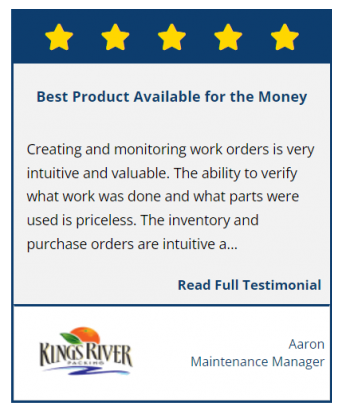
As we start a whole new year, most of us are functioning under different circumstances as a result of recent events. The metrics we have been using to assess the effectiveness and efficiency of our facilities need to be updated to better reflect our modified business procedures and goals.
What Are KPIs for Maintenance?
Key performance indicators (KPIs) are performance measures that can be used to track an organization’s overall performance as well as the efficiency with which goals are being attained.
The Importance of Maintenance Management Metrics
Effective maintenance management relies heavily on maintenance management metrics because they offer a simple and quantifiable approach to monitoring the effectiveness of maintenance activities. Organizations can get important insights into the effectiveness and efficiency of their maintenance activities by gathering and evaluating data on key performance metrics. Making educated judgments regarding resource allocation, ensuring compliance with laws and industry standards, and identifying areas for improvement can all be aided by these metrics.

Overall, maintenance management metrics are essential for monitoring and improving the performance of maintenance operations, ensuring compliance, and making informed decisions about resource allocation.
Advantages Of Maintenance KPIs
The following are some of the main advantages of maintenance management metrics:
Increased equipment reliability: By monitoring indicators like the mean time between failures and downtime, businesses can identify equipment problems early and fix them before they become expensive failures.
Reduced maintenance expenses: Organizations can find opportunities to save costs and boost efficiency by monitoring measures like maintenance costs and labor hours.
Increased safety: Organizations can identify possible hazards and take action to mitigate them by measuring metrics like safety incidents and near misses.
Enhance decision-making: Organizations can make data-driven decisions about resource allocation, equipment procurement, and other crucial maintenance-related decisions by examining data on various maintenance indicators.
Improved communications: Metrics for maintenance management can assist managers in informing higher management, stakeholders, and other departments about the performance of their departments.
Compliance: KPIs for maintenance must be tracked and monitored in sectors like aviation, healthcare, and transportation. Setting and monitoring maintenance KPIs can aid firms in adhering to rules and specifications.
What Differentiates Maintenance Metrics From Maintenance KPIs?
KPIs monitor how well an organization achieves its objectives. Are you lowering expenses and downtime? KPIs provide the reality on your path to ongoing improvement.
There are a few different categories of maintenance KPIs such as, leading and lagging indicators. Metrics like Preventative Maintenance Compliance or Estimate vs. Actual Performance are examples of leading indicators, which predict future events. Mean Time Between Failure (MTBF) and Mean Time to Repair are examples of lagging indicators for maintenance (MTTR). A combination of leading and lagging indicators is used in the most thorough CMMS KPI tracking.
Some examples of maintenance KPIs include:
Minimize Downtime
Reduce Costs
Reduce Failures
Improved Work Planning
Identifying work that needs to be performed
Increased Efficiency in Work Scheduling
Improved Workflow Execution
Maintenance performance metrics are another important aspect to consider in meeting your goals. While KPIs provide an objective measure of progress toward your most important goals, success depends on keeping a close eye on maintenance performance measurements. Metrics for maintenance performance keep track of the personnel, equipment, processes, and inventory that affect your ability to accomplish your objectives.
With the help of CMMS, you can track maintenance performance metrics and turn the resulting KPI data into meaningful dashboards and reports.
Important Metrics You Should Pay Attention To
1. Mean Time to Repair (MTTR)
Mean Time To Repair (MTTR) is a crucial Key Performance Indicator (KPI) that shows how long it typically takes to identify and repair faulty equipment and get it back to working order.
Calculating MTTR

- Total time spent on unplanned maintenance for an asset.
- Divide that number by the number of failures that occurred with that equipment over a defined period of time.
MTTR can significantly affect an organization’s bottom line and result in lost orders and business goals. Organizations can gain a better understanding of the necessary personnel, inventory management, and data-based decisions to repair vs. replace by tracking and monitoring this data. It also provides a method for assessing how successfully a company handles equipment issues and repair
2. Mean Time Between Failures (MTBF)
Mean Time Between Failures (MTBF) is a KPI that measures the reliability of an asset as well as the interval between failures. MTBF measurements offer accurate and comprehensive information on the condition of assets.
Calculating MTBF

- Identify the total number of operational hours for a specific asset over a defined timeframe.
- Divide that number by the number of failures that happened during that timeframe.
A low MTBF can be contributed to either an operator error or past repairs that were not satisfactorily made.
MTBF is an important metric for determining an asset’s reliability and forecasting future performance. By carefully monitoring this KPI and related performance measures like downtime, uptime, and the frequency of failures, organizations may improve their preventative maintenance routines. Businesses can use MTBF to decide on preventative maintenance chores like the frequency of inspections or to implement preventive measures like lubrication, greasing, and calibrations. This can lessen the chance of performing unnecessary maintenance on a piece of equipment and help prevent unforeseen failures.
3. Mean Time To Failures (MTTF)
Mean Time To Failure (MTTF) is a KPI that measures the reliability of non-repairable equipment. It calculates how long an asset is anticipated to function before failing. MTTF is used when fixing an asset is not an option, in comparison to MTBF which is used for repairable objects.
Calculating MTTF

- Take the total number of operational hours and divide that by the number of assets you’re monitoring.
MTTF is particularly useful as a reliability metric. As a dependability metric, MTTF is especially helpful. It can be used by engineers to predict how long a part might last when incorporated into a larger piece of machinery. This is especially true if the equipment in question is sensitive to failure throughout the entire business process. A shorter MTTF means more frequent downtime as the failing items need to be replaced.
4. Overall Equipment Effectiveness (OEE)
The OEE measures the business’ overall effectiveness, allowing you to determine if the procedures you’ve implemented are effective or could be improved. This is one of the most useful measures and provides you with more information about:
- How frequently assets are available to work.
- The performance and speed of your manufacturing process.
- How many goods or services are produced or carried out without flaws or failures?
Calculating OEE

- Availability is calculated as the ratio of Run Time to Planned Production Time.
- Performance is calculated by comparing current production against projections.
- Quality comes from the total production minus the items that are defective.
5. Work Order Backlog
Once you track preventive maintenance and look to improve it, You can start tracking work order backlogs and developing strategies to improve them. To reduce damages and guarantee smooth operations, your maintenance crew should have a good handle on the backlog of building maintenance. Almost all facilities have a backlog, which is thought of as all work that has been completed after its due date.
The backlog occasionally isn’t that awful, though. For instance, if you, as a facility manager, prioritize vital work over other work that isn’t as critical, you won’t necessarily mind if the non-critical work accumulates in the backlog.
6. Measuring Average Time To Completion
The average time to completion is another straightforward KPI that you may track. What the average time to completion essentially does is measure how quickly your staff completes work orders.
This KPI can help in identifying inconsistencies and inefficiencies in your operations and can provide you with an idea of what needs to be improved in operations.
7. Planned Maintenance
The percentage of maintenance hours that are spent on planned vs unplanned maintenance activities is known as the planned maintenance percentage. The scheduled maintenance labor hours are divided by the overall maintenance labor hours for the given time period to determine this percentage.
9. Reactive Maintenance
This measurement, which is based on the total number of maintenance labor hours, is used to determine when maintenance work must be done outside of the regular daily or weekly maintenance schedule. After an item of equipment malfunctions, repairs are made as part of reactive maintenance, also known as breakdown maintenance. Unplanned downtime interrupts corporate operations and may result in delayed deliveries, fewer consumers, increased production costs, and revenue losses. Failures arise haphazardly in the reactive method, and personnel loses time trying to fix the problems immediately.
8. Preventive Maintenance
Preventive maintenance is a good replacement for reactive maintenance in the workplace, as anyone involved in facility management would know. As it can help reduce downtime and additional expenditures, preventative maintenance is known to be more cost-effective than reactive maintenance.
It is usually a good idea to be aware of the overall percentage of maintenance that is carried out according to preventive schedules. You can invest in some measures to help the setup be more effective once you know what the percentages for reactive and preventive maintenance are, respectively. The KPI can lower your expenses and guarantee that the company experiences little downtime.
Preventive maintenance is a type of planned maintenance. Once PM tasks are identified based on time or equipment usage, planned maintenance organizes the resources needed and prioritizes work orders for their effective completion.
9. Planned Scheduled Maintenance
The term “planned maintenance” describes a maintenance procedure that specifies the materials that will be required to repair a particular piece of equipment. Choosing which tasks to perform and how to complete them is the objective.
Planning maintenance entails recognizing potential equipment problems, identifying the processes necessary for maintenance, and acquiring the requisite equipment and parts. A maintenance manager is responsible for overseeing the equipment inspections, process descriptions, ordering of replacement parts, and job prioritization that make up the scheduled maintenance planning process.
10. Root Cause
This metric helps you to get a deeper understanding of why problems occur and what their root cause was. With the use of this metric, you may better comprehend the causes of issues and the reasons they arise. This thorough understanding will help maintenance crews in finding solutions more quickly. If the study reveals that it was a mistake made by a person, this is a solid indication that your personnel needs more training to prevent future problems. The bottom line is that you must pinpoint any problems and their underlying causes in order to take the required steps to resolve them and put in place procedures to reduce the likelihood that they will occur.
Maintenance KPI Goals and eWorkOrders
Organizations may define and track KPIs for everything from productivity to the overall maintenance performance of their business with the help of maintenance management software like eWorkOrders CMMS. A CMMS, enables users to create baselines that measure and reveal areas for improvement.
With the help of a CMMS, you can track repair orders, labor costs, and metrics for preventive maintenance, do advanced reporting, and evaluate all of your KPIs. from one centralized system.